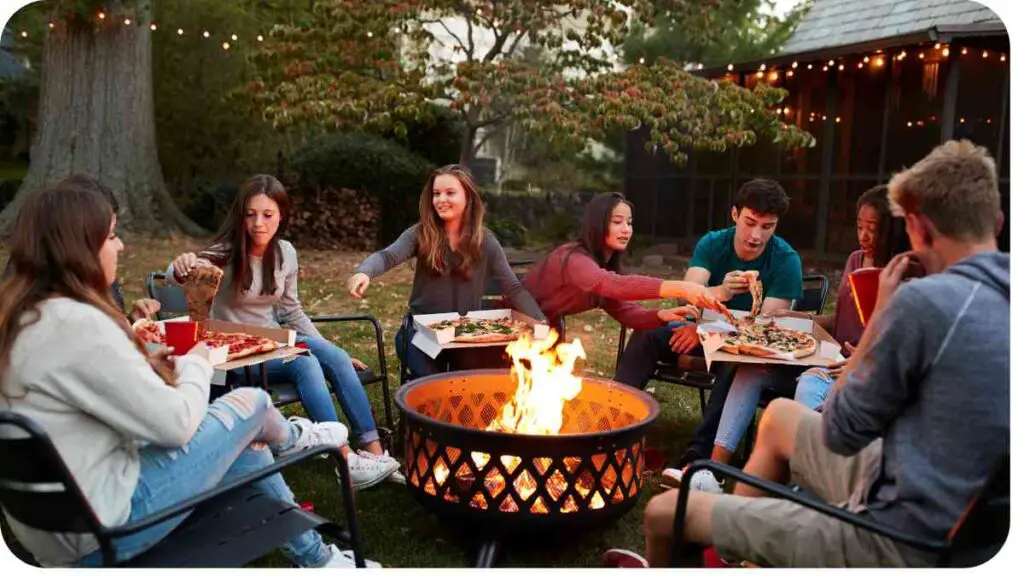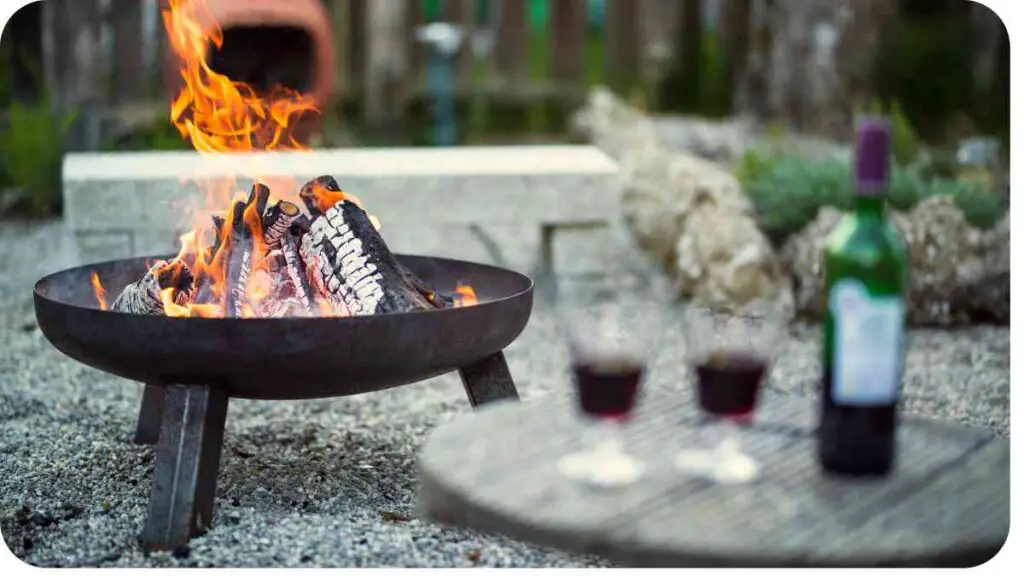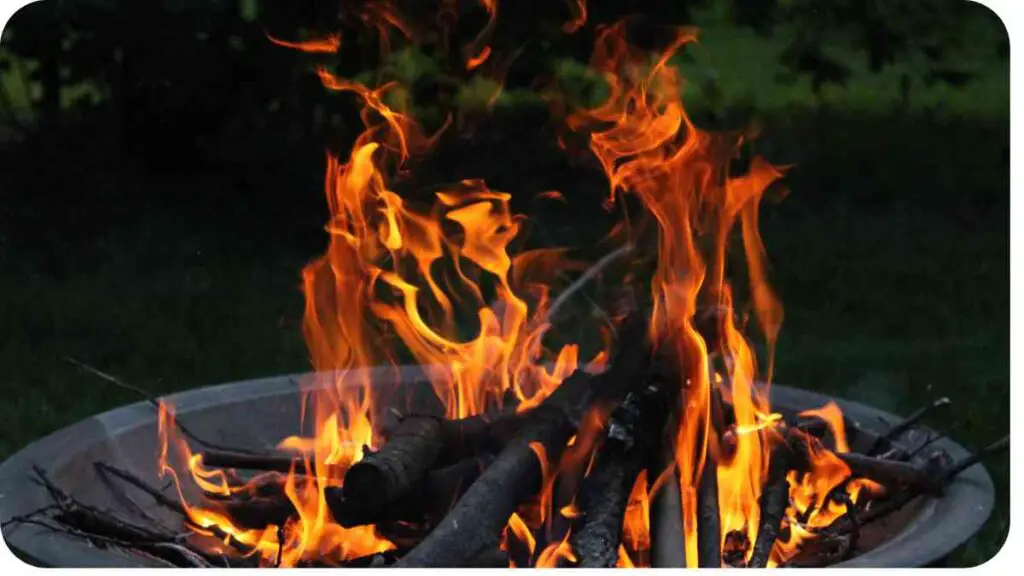Outdoor fire pits are a delightful addition to any backyard, offering warmth, ambiance, and a focal point for gatherings. However, like any outdoor appliance, they can encounter various issues that may dampen your enjoyment. In this guide, we’ll explore common problems with outdoor fire pits and provide practical solutions to troubleshoot these issues effectively.
| Key Takeaways |
|---|
| 1. Regularly inspect and clean burner and ignition components. |
| 2. Ensure adequate fuel supply and proper gas pressure. |
| 3. Use dry, seasoned firewood to minimize smoke production. |
| 4. Apply a protective coating and cover when not in use to prevent rust and corrosion. |
| 5. Check for gas leaks regularly and replace damaged components promptly. |
| 6. Use wind guards or position fire pits strategically to mitigate wind interference. |
| 7. Follow a maintenance checklist and refer to manufacturer guidelines for troubleshooting. |
Common Problems with Outdoor Fire Pits

Outdoor fire pits can experience a range of problems, from ignition issues to maintenance challenges. Let’s delve into some of the most frequent issues and how to address them.
Table 1: Common Issues and Solutions
| Problem | Solution |
|---|---|
| Difficulty Igniting the Fire | Check gas supply and ignition system. |
| Uneven Flames or Heat Distribution | Clean burner and ensure proper airflow. |
| Excessive Smoke | Use dry, seasoned firewood and maintain proper ventilation. |
| Gas Leaks | Inspect gas lines regularly for leaks and replace damaged parts. |
| Rust and Corrosion | Apply rust-resistant coating and cover when not in use. |
Ignition Problems
One of the most frustrating issues you might encounter with your outdoor fire pit is difficulty getting the fire started. Whether you’re dealing with a gas or wood-burning fire pit, ignition problems can quickly put a damper on your outdoor gathering.
When facing issues with your outdoor fire pit, remember that troubleshooting common irrigation system problems can offer insights. Proper water management ensures a functional and safe outdoor space.
Table 2: Troubleshooting Ignition Problems
| Issue | Solution |
|---|---|
| Igniter Not Working | Replace the igniter or check for obstructions in the ignition path. |
| Gas Flow Issues | Verify gas supply and ensure valves are fully open. |
| Wet or Damp Firewood | Allow firewood to dry thoroughly before use. |
When troubleshooting ignition problems, start by checking the igniter. If it’s not producing a spark, it may need to be replaced. Additionally, ensure there are no obstructions blocking the ignition path, such as debris or insects.
If you have a gas fire pit, verify that the gas supply is adequate and that all valves are fully open. Sometimes, a simple adjustment of the gas flow can resolve ignition issues.
If you’re using a wood-burning fire pit, make sure your firewood is dry and seasoned. Wet or damp firewood can be difficult to ignite and may produce excessive smoke.
Fuel Supply Issues
Another common issue with outdoor fire pits is related to the fuel supply, particularly in gas fire pits. Problems with the fuel supply can result in weak flames, intermittent operation, or difficulty igniting the fire.
Cracks in your patio can detract from the beauty and safety of your outdoor area. Learn how to address them effectively with this step-by-step guide for patio repair.
Table 3: Fuel Supply Problems and Fixes
| Issue | Solution |
|---|---|
| Empty Propane Tank | Replace or refill propane tank. |
| Clogged Gas Line | Clear debris from the gas line using compressed air or a brush. |
| Faulty Regulator | Replace the regulator if it’s malfunctioning. |
If you’re using a propane fire pit, check the propane tank to ensure it’s not empty. Replace or refill the tank as needed to maintain a steady fuel supply. Additionally, inspect the gas line for any clogs or obstructions that may be impeding the flow of gas. Use compressed air or a brush to clear any debris from the gas line.
If you suspect a problem with the regulator, such as inconsistent gas flow or difficulty maintaining a flame, it may need to be replaced. Faulty regulators can disrupt the fuel supply and affect the performance of your fire pit.
Uneven Flames or Heat Distribution

Uneven flames or heat distribution can detract from the comfort and visual appeal of your outdoor fire pit. This issue may manifest as certain areas of the fire pit producing more intense heat or flames than others, leading to an uneven heating experience.
Table 4: Troubleshooting Uneven Flames
| Issue | Solution |
|---|---|
| Blocked Burner Openings | Clean burner ports to ensure even gas distribution. |
| Uneven Gas Pressure | Adjust gas pressure regulator to achieve uniform flames. |
| Wind Interference | Use a wind guard or position the fire pit in a sheltered area. |
To address uneven flames or heat distribution, start by inspecting the burner openings. Over time, debris, insects, or corrosion can block the burner ports, disrupting the flow of gas and leading to uneven flames. Clean the burner thoroughly to ensure even gas distribution across all burner openings.
In some cases, uneven flames may be caused by fluctuations in gas pressure. If you notice inconsistent flame heights or patterns, adjust the gas pressure regulator to achieve a more uniform flame output.
Wind interference can also contribute to uneven flames by disrupting the flow of gas or causing flames to flicker unpredictably. Consider using a wind guard to shield the flame from strong gusts of wind, or position the fire pit in a sheltered area to minimize wind interference.
Excessive Smoke
Excessive smoke emanating from your outdoor fire pit can be both bothersome and potentially harmful, especially if you’re hosting guests or cooking food nearby. Understanding the causes of excessive smoke and how to mitigate them is crucial for enjoying your fire pit safely and comfortably.
Enhancing your outdoor ambiance often involves troubleshooting lighting issues. If your outdoor solar lights aren’t charging properly, follow these troubleshooting tips to ensure they illuminate your space effectively.
Table 5: Reasons for Excessive Smoke
| Cause | Solution |
|---|---|
| Wet or Green Firewood | Use dry, seasoned firewood to minimize smoke production. |
| Poor Ventilation | Ensure adequate airflow around the fire pit to reduce smoke buildup. |
| Excessive Fuel | Avoid overloading the fire pit with fuel, which can lead to smoldering and increased smoke. |
Excessive smoke is often caused by burning wet or green firewood, which produces more smoke as it struggles to ignite and burn efficiently. To minimize smoke production, use dry, seasoned firewood with a moisture content of around 20% or less.
Poor ventilation around the fire pit can also contribute to excessive smoke buildup. Ensure there’s sufficient airflow around the fire pit to allow smoke to dissipate quickly. Positioning the fire pit in an open area away from obstructions can help improve ventilation.
Additionally, avoid overloading the fire pit with fuel, as excessive fuel can lead to smoldering and increased smoke production. Instead, add fuel gradually and maintain a moderate flame to minimize smoke output.
Rust and Corrosion
Rust and corrosion are common issues that outdoor fire pits face, especially if they’re exposed to the elements year-round. Rust can not only detract from the aesthetic appeal of your fire pit but also compromise its structural integrity over time. Preventative measures and regular maintenance are key to combating rust and corrosion effectively.
Effective drainage is essential for maintaining healthy outdoor spaces, including container gardens. Discover strategies for dealing with drainage problems to promote the vitality of your plants and outdoor features.
Table 6: Preventing Rust and Corrosion
| Prevention Method | Description |
|---|---|
| Apply a Protective Coating | Use heat-resistant paint or spray to create a barrier against rust. |
| Cover When Not in Use | Invest in a weatherproof cover to shield the fire pit from the elements. |
| Keep Fire Pit Clean | Regularly remove debris and ashes from the fire pit to prevent buildup. |
To prevent rust and corrosion, consider applying a protective coating to your fire pit. Heat-resistant paints or sprays can create a barrier that shields the metal from moisture and oxidation. Be sure to choose a coating specifically designed for outdoor use and follow the manufacturer’s instructions for application.
When your fire pit is not in use, it’s essential to cover it with a weatherproof cover to protect it from rain, snow, and other elements. A durable cover will help prevent moisture from seeping into the metal and causing rust over time.
Regular maintenance is also crucial for preventing rust and corrosion. Routinely remove debris, ashes, and other contaminants from the fire pit to prevent buildup that can accelerate corrosion. Cleaning your fire pit after each use and inspecting it periodically for signs of rust will help keep it in optimal condition for years to come.
Gas Leaks
Gas leaks are a serious safety concern with gas-powered fire pits and can pose a risk of fire or explosion if left unchecked. Detecting and addressing gas leaks promptly is essential for ensuring the safety of your outdoor space and preventing accidents.
Table 7: Detecting and Fixing Gas Leaks
| Method | Description |
|---|---|
| Check Gas Connections | Inspect gas connections for signs of damage or wear. |
| Test with Soapy Water | Apply a mixture of soap and water to gas connections to check for bubbles. |
| Replace Damaged Components | Replace any damaged or worn-out gas lines, connectors, or fittings. |
To detect gas leaks, start by inspecting all gas connections, including hoses, valves, and fittings, for signs of damage or wear. Look for cracks, corrosion, or loose connections that could indicate a potential leak. Tighten loose connections and replace any damaged components as needed to prevent gas leaks.
One effective method for detecting gas leaks is to perform a simple test using soapy water. Mix a small amount of dish soap with water and apply the solution to the gas connections using a brush or spray bottle. Watch for bubbles forming at the connections, as this indicates a gas leak. If you detect any leaks, turn off the gas supply immediately and repair or replace the affected components.
In some cases, gas leaks may occur due to worn-out or deteriorated gas lines, connectors, or fittings. If you suspect a gas leak but can’t pinpoint the source, consider replacing these components to ensure the safety of your fire pit.
Wind Interference
Wind interference can disrupt the flames of your outdoor fire pit, causing uneven heating and potentially extinguishing the fire altogether. Understanding how to mitigate the effects of wind interference is essential for maintaining a consistent and enjoyable outdoor fire experience.
Rusty outdoor tools can hinder your fire pit maintenance efforts. Ensure your tools remain in top condition with these maintenance tips, preventing rust and prolonging their lifespan.
Table 8: Tips for Dealing with Wind Interference
| Strategy | Description |
|---|---|
| Use a Wind Guard | Install a wind guard around the fire pit to shield the flames from wind. |
| Position the Fire Pit Strategically | Place the fire pit in a sheltered area or create a windbreak with landscaping or structures. |
| Adjust Flame Height | Lower the flame height to minimize the effects of wind on the fire. |
One effective way to mitigate wind interference is to install a wind guard around the perimeter of your fire pit. A wind guard acts as a barrier, protecting the flames from gusts of wind and maintaining a steady flame. You can purchase a pre-made wind guard or construct one using tempered glass or metal panels.
Strategically positioning your fire pit can also help reduce the impact of wind interference. Choose a location that’s sheltered from prevailing winds, such as against a wall or building, or create a windbreak using landscaping features or outdoor structures.
Additionally, adjusting the height of the flame can help minimize the effects of wind on your fire pit. Lowering the flame height reduces its susceptibility to being extinguished by strong gusts of wind, ensuring a more consistent and enjoyable outdoor fire experience.
Maintenance Tips for Outdoor Fire Pits

Regular maintenance is key to keeping your outdoor fire pit in optimal condition and ensuring safe and reliable operation. By following a few simple maintenance tasks, you can prolong the lifespan of your fire pit and enjoy countless evenings gathered around the warmth of the flames.
Table 9: Maintenance Checklist
| Task | Frequency |
|---|---|
| Clean Burner and Ignition Components | After Each Use |
| Inspect Gas Connections | Monthly |
| Remove Debris and Ashes | After Each Use |
| Apply Rust-Resistant Coating | Annually |
After each use, take the time to clean the burner and ignition components of your fire pit to remove any debris or residue that may have accumulated. Inspect gas connections regularly, ideally on a monthly basis, to ensure they’re in good condition and free from leaks or damage.
Removing debris and ashes from the fire pit after each use helps prevent buildup that can impede airflow and contribute to rust and corrosion. Use a brush or ash shovel to clear away any debris, and dispose of ashes in a safe and appropriate manner.
Annually, apply a rust-resistant coating to your fire pit to protect it from corrosion and oxidation. This extra layer of protection helps prolong the lifespan of your fire pit and maintain its aesthetic appeal for years to come.
Conclusion
Troubleshooting issues with outdoor fire pits is crucial for maintaining a safe and enjoyable outdoor experience. By proactively addressing common problems such as ignition issues, fuel supply problems, uneven flames, excessive smoke, rust, corrosion, gas leaks, and wind interference, you can ensure that your fire pit remains a reliable centerpiece for outdoor gatherings.
Regular maintenance is key to extending the lifespan of your fire pit and preserving its functionality and appearance. By following the maintenance checklist provided and implementing the recommended strategies for dealing with specific issues, you can minimize downtime and maximize the enjoyment of your outdoor space.
Remember to stay vigilant and responsive to any signs of trouble, as each fire pit may have unique characteristics and requirements. If you encounter persistent issues or need assistance, don’t hesitate to seek guidance from experts or refer to the manufacturer’s guidelines.
Further Reading
- Troubleshooting Your Gas Fire Pit: This comprehensive guide offers troubleshooting tips specifically tailored to gas fire pits, addressing common issues such as ignition problems, fuel supply issues, and more.
- Gas Fire Pit Troubleshooting 101: Dive into this troubleshooting 101 guide to learn about troubleshooting techniques for gas fire pits, covering everything from ignition failures to uneven flames.
- Brightstar Fires Troubleshooting Guide: This troubleshooting guide from Brightstar Fires provides a detailed overview of common issues encountered with fire pits, along with step-by-step solutions to address them effectively.

Hi! My name is Hellen James, and I’m here to help you with your home-maintenance needs. Whether it’s building a better yard or just trying to fix a garden—I can show you how.


